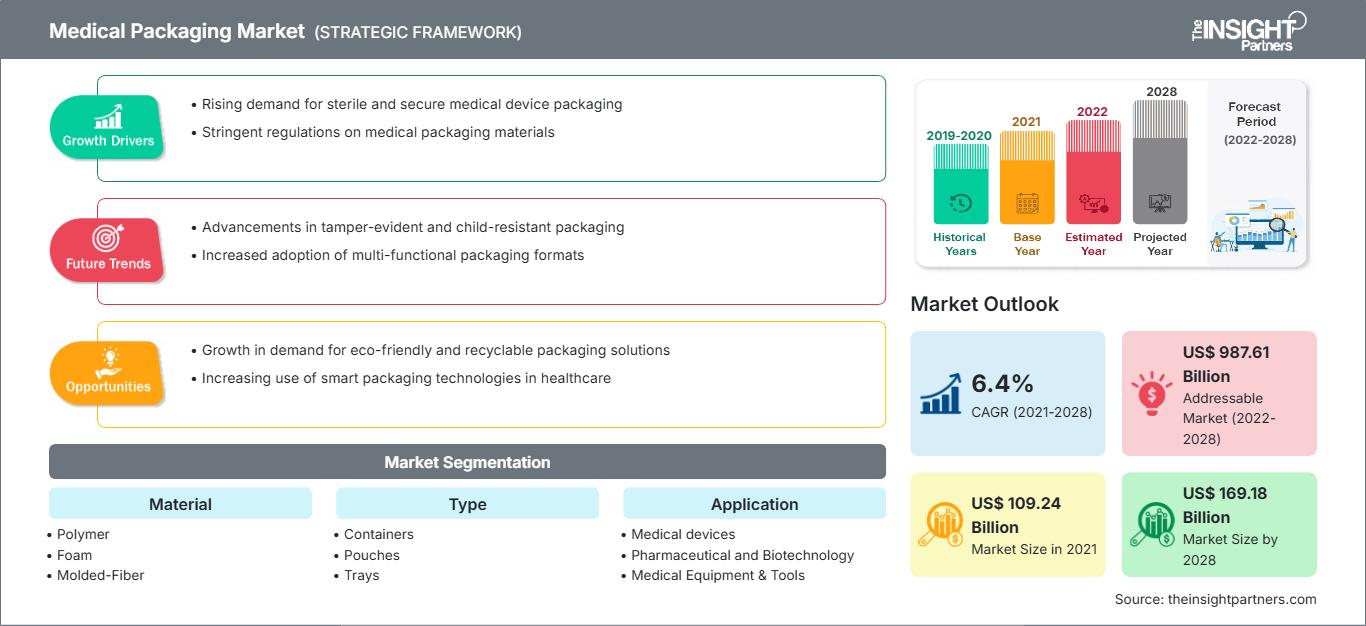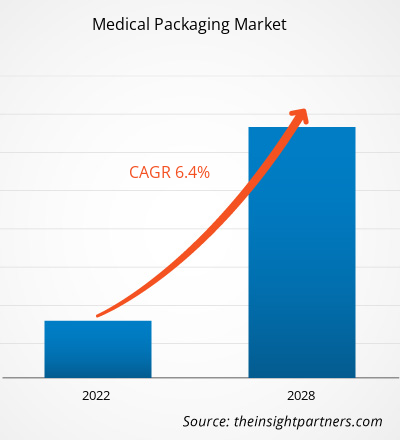Der Markt für medizinische Verpackungen soll von 109.238,35 Millionen US-Dollar im Jahr 2021 auf 169.183,91 Millionen US-Dollar im Jahr 2028 anwachsen; von 2021 bis 2028 wird ein durchschnittliches jährliches Wachstum von 6,4 % erwartet.
Medizinische Verpackungen sind unerlässlich, um die Produktqualität zu erhalten und eine sichere und wirksame Anwendung zu gewährleisten. Verpackungen dienen der Sicherheit medizinischer Produkte bei Lagerung, Vertrieb, Verkauf und Anwendung. Das für die Verpackung verwendete Material ist ein steriles Barrieresystem, das Medikamente, Geräte und andere medizinische Produkte schützt. Außerdem erfordern medizinische Verpackungen ein hohes Maß an Sterilität, um sicherzustellen, dass das Produkt frei von Verunreinigungen ist. Diese medizinischen Verpackungssysteme erhöhen die Patientensicherheit und verbessern die Verpackungsleistung. Faktoren wie die zunehmende Betonung von Komfort und Umweltaspekten sowie die steigende Nachfrage nach Mechanismen zur Fälschungsprävention treiben den Markt für medizinische Verpackungen an. Allerdings ist zu erwarten, dass Schwankungen bei den Rohstoffpreisen das Marktwachstum im Prognosezeitraum bis zu einem gewissen Grad einschränken werden.
Passen Sie diesen Bericht Ihren Anforderungen an
Sie erhalten kostenlos Anpassungen an jedem Bericht, einschließlich Teilen dieses Berichts oder einer Analyse auf Länderebene, eines Excel-Datenpakets sowie tolle Angebote und Rabatte für Start-ups und Universitäten.
Markt für medizinische Verpackungen: Strategische Einblicke

- Holen Sie sich die wichtigsten Markttrends aus diesem Bericht.Dieses KOSTENLOSE Beispiel umfasst Datenanalysen, die von Markttrends bis hin zu Schätzungen und Prognosen reichen.
Sie erhalten kostenlos Anpassungen an jedem Bericht, einschließlich Teilen dieses Berichts oder einer Analyse auf Länderebene, eines Excel-Datenpakets sowie tolle Angebote und Rabatte für Start-ups und Universitäten.
Markt für medizinische Verpackungen: Strategische Einblicke

- Holen Sie sich die wichtigsten Markttrends aus diesem Bericht.Dieses KOSTENLOSE Beispiel umfasst Datenanalysen, die von Markttrends bis hin zu Schätzungen und Prognosen reichen.
Markteinblicke
Steigende Nachfrage nach Mechanismen zur Fälschungsprävention
In den meisten Mitgliedstaaten und allen Regionen wurden gefälschte Medizinprodukte entdeckt. Beispiele hierfür sind weit verbreitete Medikamente wie Atorvastatin oder Paracetamol, Medikamente mit begrenzter Wirkung wie Wachstumshormone, Paclitaxel und Filgastrim sowie andere Arzneimittel wie Sildenafil und Tadalafil, aber auch Medizinprodukte wie Kontaktlinsen, Kondome, chirurgisches Netz und Teststreifen für Diabetiker zur Überwachung ihres Blutzuckerspiegels. Von Fälschungen sind sowohl teure als auch billige Produkte sowie Generika und Markenprodukte betroffen. Gefälschte Produkte tauchen in Apotheken, Krankenhäusern und anderen weniger regulierten Einrichtungen auf.
Es wird oft angenommen, dass Länder mit hohem Einkommen und soliden Regulierungssystemen minderwertige und gefälschte Medizinprodukte wirksam von ihren Märkten fernhalten können. Die Analyse der Weltgesundheitsorganisation (WHO) zeigt jedoch, dass dies nicht unbedingt der Fall ist, da Berichte über diese Produkte aus Ländern Westeuropas und Nordamerikas sowie aus anderen Ländern mit hohem Einkommen eingereicht wurden. So kommt beispielsweise eine aktuelle britische Umfrage, die von Sapio Research durchgeführt und von dem privaten Unternehmen INCOPRO in Auftrag gegeben wurde, zu dem Schluss, dass fast ein Drittel (32 %) derjenigen, die ein oder mehrere gefälschte Medikamente gekauft haben, infolgedessen gesundheitliche Probleme erlitten haben (INCOPRO, 2020). Es gibt zahlreiche weitere dokumentierte Fälle, in denen Patienten aufgrund eines Online-Kaufs gestorben sind oder Schaden erlitten haben. Um nur ein Beispiel zu nennen: Im Jahr 2013 starben Menschen, nachdem sie eine gefälschte Diätpille eingenommen hatten, die sie über einen Online-Arzneimittelhändler erworben hatten. Die Pille, die von vielen illegalen Online-Apotheken als Mittel zur Gewichtsabnahme verkauft wurde, war in Wirklichkeit ein Pestizid mit tödlichen Folgen für Menschen.
Die Bedrohung, die gefälschte Medikamente für den globalen Pharmasektor darstellen, ist enorm. Von gefälschten Rezepturen bis hin zu Problemen im Herstellungsprozess – einige Branchenkenner gehen davon aus, dass uns allein in Europa Umsatzeinbußen von bis zu 27 Milliarden Euro bevorstehen. Die International Hologram Manufacturers Association (IHMA) ist eine gute Quelle für Fachwissen auf diesem Gebiet und verweist auf einen Branchenbericht, der auf ein anhaltendes Wachstum bei fälschungssicheren Verpackungstechnologien hinweist. Laut IHMA unterstreicht der Bericht „Technologien zur Fälschungs-, Authentifizierungs- und Verifizierungsbekämpfung“ die zusätzliche Expertise, die Holografie zur Authentifizierung von Verpackungsprodukten beiträgt. Technologische Innovationen im Bereich der Fälschungs-, Authentifizierungs- und Verifizierungstechnologien sind ein bedeutender Faktor für das Marktwachstum.
Die steigende Nachfrage nach Fälschungsschutztechniken zum Schutz der Patienteninteressen hat das Wachstum im Bereich medizinischer Verpackungen weiter gestärkt.
Typbasierte Erkenntnisse
Basierend auf dem Typ wird der Markt für medizinische Verpackungen in Behälter, Beutel, Schalen, Blisterpackungen, Fläschchen und andere unterteilt. Im Jahr 2021 hatte das Behältersegment nach Typ den größten Marktanteil. Das Blisterverpackungssegment wird im Prognosezeitraum aufgrund zunehmender Produktentwicklungen und Produkteinführungen voraussichtlich mit einer signifikanten CAGR wachsen.
Materialbasierte Erkenntnisse
Basierend auf dem Material wurde der Markt für medizinische Verpackungen in Polymer, Schaumstoff, Formfaser, Vliesstoff, Folien, Papier & Pappe und Sonstiges segmentiert. Im Jahr 2021 hatte das Polymersegment nach Material den größten Marktanteil. Außerdem wird erwartet, dass ein ähnliches Segment in den kommenden Jahren am schnellsten wächst.
Anwendungsbasierte Erkenntnisse
Basierend auf der Anwendung wurde der Markt für medizinische Verpackungen in Medizinprodukte, Pharmazie und Biotechnologie, medizinische Geräte & Werkzeuge und Sonstiges segmentiert. Im Jahr 2021 hatte das Segment Pharmazie und Biotechnologie den größten Marktanteil. Für dasselbe Segment wird im Prognosezeitraum ein signifikantes CAGR-Wachstum erwartet, da aufgrund der zunehmenden Verbreitung chronischer Krankheiten die Produktion pharmazeutischer und biotechnologischer Produkte auf den Weltmärkten steigt.
Verschiedene auf dem Markt für medizinische Verpackungen tätige Unternehmen verfolgen Strategien wie Produkteinführungen, Fusionen und Übernahmen, Kooperationen, Produktinnovationen und Produktportfolioerweiterungen, um ihre Präsenz weltweit auszubauen, ihren Markennamen zu wahren und die wachsende Nachfrage der Endverbraucher zu befriedigen.
Medizinische VerpackungenRegionale Einblicke in den Markt für medizinische Verpackungen
Die Analysten von The Insight Partners haben die regionalen Trends und Faktoren, die den Markt für medizinische Verpackungen im Prognosezeitraum beeinflussen, ausführlich erläutert. In diesem Abschnitt werden auch die Marktsegmente und die geografische Lage in Nordamerika, Europa, dem asiatisch-pazifischen Raum, dem Nahen Osten und Afrika sowie Süd- und Mittelamerika erörtert.
Umfang des Marktberichts für medizinische Verpackungen
| Berichtsattribut | Einzelheiten |
|---|---|
| Marktgröße in 2021 | US$ 109.24 Billion |
| Marktgröße nach 2028 | US$ 169.18 Billion |
| Globale CAGR (2021 - 2028) | 6.4% |
| Historische Daten | 2019-2020 |
| Prognosezeitraum | 2022-2028 |
| Abgedeckte Segmente |
By Material
|
| Abgedeckte Regionen und Länder | Nordamerika
|
| Marktführer und wichtige Unternehmensprofile |
|
Dichte der Marktteilnehmer für medizinische Verpackungen: Verständnis ihrer Auswirkungen auf die Geschäftsdynamik
Der Markt für medizinische Verpackungen wächst rasant. Die steigende Nachfrage der Endverbraucher ist auf Faktoren wie veränderte Verbraucherpräferenzen, technologische Fortschritte und ein stärkeres Bewusstsein für die Produktvorteile zurückzuführen. Mit der steigenden Nachfrage erweitern Unternehmen ihr Angebot, entwickeln Innovationen, um den Bedürfnissen der Verbraucher gerecht zu werden, und nutzen neue Trends, was das Marktwachstum weiter ankurbelt.

- Holen Sie sich die Markt für medizinische Verpackungen Übersicht der wichtigsten Akteure
Markt für medizinische Verpackungen – nach Typ
- Behälter
- Beutel
- Schalen
- Blisterpackungen
- Fläschchen
- Sonstige
Markt für medizinische Verpackungen – nach Material
- Polymer
- Schaum
- Formfaser
- Vliesstoff
- Folien
- Papier & Pappe
- Sonstige
Markt für medizinische Verpackungen – nach Anwendung
- Medizinische Geräte
- Pharmazeutisch und Biotechnologie
- Medizinische Geräte & Werkzeuge
- Sonstige
Markt für medizinische Verpackungen – nach Geografie
Nordamerika
- USA
- Kanada
- Mexiko
Europa
- Frankreich
- Deutschland
- Italien
- Großbritannien
- Spanien
- Restliches Europa
Asien-Pazifik (APAC)
- China
- Indien
- Südkorea
- Japan
- Australien
- Restlicher Asien-Pazifik-Raum
Naher Osten & Afrika (MEA)
- Südafrika
- Saudi-Arabien
- VAE
- Rest des Nahen Ostens und Afrikas
Südamerika (SAM)
- Brasilien
- Argentinien
- Rest Süd- und Mittelamerika
Firmenprofile
- Amcor plc
- DuPont de Nemours, Inc.
- Mitsubishi Chemical Corporation
- SGD Pharma
- 3M
- West Pharmaceutical Services, Inc
- Avery Dennison Corporation
- Sonoco Products Company
- CCL Industries Inc.
- WestRock Company
- Historische Analyse (2 Jahre), Basisjahr, Prognose (7 Jahre) mit CAGR
- PEST- und SWOT-Analyse
- Marktgröße Wert/Volumen – Global, Regional, Land
- Branchen- und Wettbewerbslandschaft
- Excel-Datensatz
Aktuelle Berichte
Verwandte Berichte
Erfahrungsberichte
Grund zum Kauf
- Fundierte Entscheidungsfindung
- Marktdynamik verstehen
- Wettbewerbsanalyse
- Kundeneinblicke
- Marktprognosen
- Risikominimierung
- Strategische Planung
- Investitionsbegründung
- Identifizierung neuer Märkte
- Verbesserung von Marketingstrategien
- Steigerung der Betriebseffizienz
- Anpassung an regulatorische Trends




















 Kostenlose Probe anfordern für - Markt für medizinische Verpackungen
Kostenlose Probe anfordern für - Markt für medizinische Verpackungen